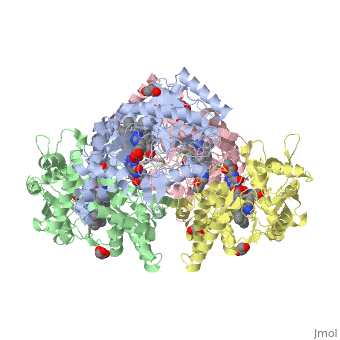Nos1
From Proteopedia
(Difference between revisions)
| Line 5: | Line 5: | ||
== Location == | == Location == | ||
| - | The human gene NOS1, found on chromosome 12, encodes for a nitric oxide synthase. Nitric oxide synthases consume L-arginine to produce nitric oxide | + | The human gene NOS1, found on chromosome 12, encodes for a nitric oxide synthase. Nitric oxide synthases consume L-arginine to produce nitric oxide. The chemical equation is shown below. |
2 L-arginine + 3 NADPH + 4 O(2) = 2 L- citrulline + 2 nitric oxide + 3 NADP(+) + 4 H(2)O | 2 L-arginine + 3 NADPH + 4 O(2) = 2 L- citrulline + 2 nitric oxide + 3 NADP(+) + 4 H(2)O | ||
| - | + | Nitric oxide is used in a wide variety of processes. A few examples of molecular processes include heme binding, NADP binding, calcium signaling, and oxidation-reduction reactions. Biological examples include regulation of cardiac muscle contraction, blood coagulation, aging, and regulation of neurogenesis. There are five known isoforms known for NOS1 in humans produced by alternative splicing, which are expressed at different levels as denoted by microarray data. Please note that microarray data is only available for isoforms 1, 3, and 4. | |
| + | Tissue Isoform 1 Isoform 3 Isoform 4 | ||
| + | Skeletal muscle Moderate N/A Moderate | ||
| + | Brain Moderate N/A Low | ||
| + | Testis Moderate Moderate Moderate | ||
| + | Lung Moderate N/A Moderate | ||
| + | Kidney Moderate N/A Moderate | ||
| + | Heart Low N/A N/A | ||
| + | Adrenal gland Low N/A N/A | ||
| + | Retina Low N/A N/A | ||
| + | |||
| + | [[Image:expression table snip.jpg]] | ||
== Function == | == Function == | ||
Revision as of 18:19, 12 April 2016
Your Heading Here (maybe something like 'Structure')
| |||||||||||
References
- ↑ Hanson, R. M., Prilusky, J., Renjian, Z., Nakane, T. and Sussman, J. L. (2013), JSmol and the Next-Generation Web-Based Representation of 3D Molecular Structure as Applied to Proteopedia. Isr. J. Chem., 53:207-216. doi:http://dx.doi.org/10.1002/ijch.201300024
- ↑ Herraez A. Biomolecules in the computer: Jmol to the rescue. Biochem Mol Biol Educ. 2006 Jul;34(4):255-61. doi: 10.1002/bmb.2006.494034042644. PMID:21638687 doi:10.1002/bmb.2006.494034042644

